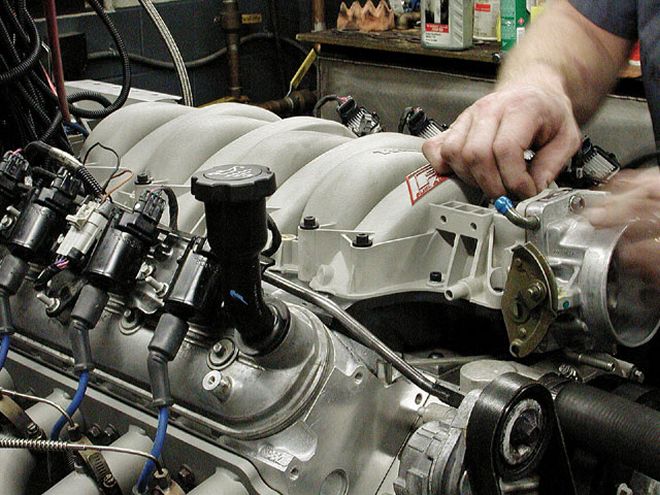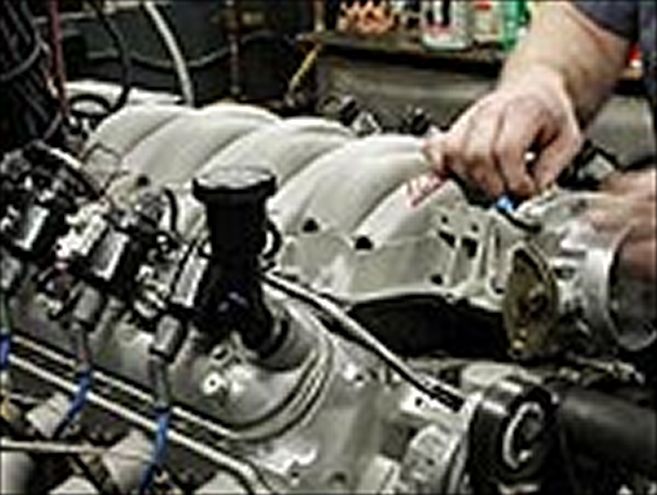


Last month, we began a simple buildup of an all-aluminum 5.3L Gen III engine that was a brand-new production overrun aluminum-block 5.3L SSR truck engine. This SSR engine is virtually a clone for the popular iron block LM7 GM truck engine, with the exception of the aluminum block. Last month, on Lingenfelter Performance Engineering's (LPE) Digalog Testmate dyno with little more than a swap to a bigger camshaft and a set of headers, we made an amazing 413 hp, which equated to a 100 hp peak-to-peak increase. But we weren't finished yet.
LPE's Project Director Jason Haines, along with expertise from "Dyno Bob" VanderHart, decided to really put the screws to our little 325ci small-block by adding some larger injectors, as well as a set of LPE's CNC-ported heads, a swap to one of Comp Cams' FAST LSX intake manifolds, along with a couple other little goodies to see if we could make this little motor sing. We'll cut right to the finish and tell you that Little Bro managed a respectable 458 hp at 6,800 rpm and 392 lb-ft of torque at 5,800 rpm.
Up To SpeedLast month we added a pretty healthy LPE-spec'd hydraulic roller cam (the details are in the Cam Box). Dyno Bob noticed that the stock fuel injectors were maxing out at 100 percent duty cycle. What we really needed was larger injectors. The stock injectors are rated at 25.4 lb/hr of fuel, which is good for between 350 and 400 hp at roughly 85 percent duty cycle with the fuel pressure at 58 psi. When you exceed 85 percent duty cycle in search of more fuel, it's time to increase the size of the fuel injectors. The next step up in the Delphi injectors is 30.2 lb/hr, good to between 400 and 475 hp, which is what we put in our 5.3L engine. It's important to note that the factory runs the 4.8 and 5.3L truck engines at a significantly richer air/fuel ratio than the passenger-car engines. According to Haines, the factory calibration for the truck engines can run as rich as 11.5:1 at wide-open throttle (WOT), to protect the exhaust valves and the catalytic converter. Our baseline testing revealed that our 5.3L engine was running around 12.2:1 air/fuel ratio.
With the larger camshaft and now with larger injectors, LPE had to go into the factory computer to rescale the fuel map to set up the proper fuel delivery curve. For these first runs, LPE had been using production ignition and fuel curves. For calibration changes, LPE uses proprietary in-house software. LS1 Edit, HP Tuner, and others offer that capability, but it's beyond the scope of this story to get into the details on specifically how that was accomplished. The LS1 Edit program is available to any enthusiast, but it does demand significant knowledge of both engine tuning and how to navigate through the complex GM computer using this software. This is not for beginners, but the software does allow tremendous latitude for spark and fuel tuning to get the most out of the changes made to the engine.
Heads UpUp until now, our changes had been relatively inexpensive with a camshaft, headers, injectors, and valvesprings. We'd added an amazing 100 hp to the stock baseline, and we were most impressed with the stock truck intake. At 413 hp, we were still using an unmolested stock truck intake manifold along with the stock 75mm throttle-body. Before we changed the intake, we decided to test a set of LPE's CNC-ported heads with the truck intake to see how well this intake would perform.
LPE actually offers four significantly different cylinder head CNC porting options for the Gen III engine plus options. There is a design for the 4.8 and 5.3L engines, another for the LS1, one for LS6 heads, and yet a fourth for the larger 6.0L engines. The stock 5.3L aluminum heads come with 1.89/1.55-inch valves along with a 62cc chamber. LPE's CNC porting generally uses 2.00-inch or larger intake valves for most combinations, but given the 5.3L's small bore size of 3.779, Haines opted for stock 2.00-inch LS1 intakes. LPE did mill the heads from the stock 62cc chamber down to 57 cc's to bump the compression from 9.45:1 to 10:1.
As you can see from the dyno power results of Test 5, the heads not only increased airflow throughout the valve lift curve, but more importantly were worth increased power throughout the entire engine test from 2,000 rpm through 6,800. As you can see from the test data, even at 2,800 rpm (for example), the ported heads are worth a solid 10 lb-ft of torque. But it's the combination of these ported cylinder heads and the larger camshaft at engine speeds above 4,400 where the combination really shines. Looking at the peak horsepower point, the LPE-ported heads were worth an amazing 33 hp over the stock heads at 5,800. Even at the peak, the heads produced a solid 24 hp, making an amazing 437 hp. Remember, we're talking about a 5.3L, 325ci truck engine here, not some big-inch thumper. This is still on pump gas and with a completely stock bottom end. This computes to a impressive 1.34 hp per cubic inch (hp/ci).
We also wanted to see what a shorter runner intake like the Comp Cams FAST LSX composite would do on our smaller 5.3L engine. In order to do this, we had to also change the front accessory drive on the engine since the truck accessory drive is very tall in the front and will not clear the lower LS1/LS6/FAST LSX-style intake throttle-body. This meant changing the entire front dress on the engine since the truck balancer/pulley arrangement is deeper than either the Camaro or Corvette style accessory drives.
With the accessory drive and intake bolted on, we chose to retain the stock 75mm throttle-body. As you can see from the comparison of Test 5 and 6, the shorter length runner manifold (along with the accessory drive) surprisingly didn't hurt the torque in the low-rpm range. Generally, a shorter runner length manifold like the LSX intake will trade off some torque for top-end horsepower gains. Some of this torque improvement is certainly attributable to the average of 6 hp gained from the change to the F-car accessory drive.
The major improvement in power occurred from 5,600 rpm and up where the LSX manifold really shined, boosting power as much as 22 hp at 6,200 compared to Test 5 (14 hp if you account for the accessory drive change). Overall, the power was impressive with this little 5.3L engine spinning up a peak of 458 hp at 6,600 and a torque peak of 392 at 5,800 rpm.
5.3l To GoIt's no secret the Gen III small-block is a stout engine that responds to virtually any breathing or camshaft modification. It turns out that the 5.3L is as responsive as its larger 5.7L LS1 brother. Do the math on this spinner and you quickly discover that this equates to 1.4 hp/ci. Granted, this combination cannot be deemed inexpensive since a complete pair of CNC-ported LPE heads will cost $1,595 (add $600 without a core) and the LSX intake is almost $800. We used these components to illustrate this small engine's potential to make outstanding pump gas power without the need for a supercharger or nitrous. If you think of this engine as a late-model 327, cranking out 450-plus horsepower from this little of an engine is plenty impressive.
The Cam Box Camshaft Adv. Duration Lift Lobe Duration @ 0.050 (inches) Sep. (0.006-inch) Stock 5.3L Int. 259 190 0.456 114.0 Hyd. Roller Ex. 259 190 0.464 LPE GT2-3 Int. 255 206 0.571 118.5 Hyd. Roller Ex. 282 221 0.578 LPE GT1-1 Int. 276 229 0.631 114.5 Hyd. Roller Ex. 303 242 0.631
Component List Description Manufacturer Part Number Camshaft, aggressive hyd. roller LPE GT1-1 CNC ported Gen III heads LPE LNO-227-350-08 Steel roller rocker stand LPE LPE-RKR-STAND Pushrods, Hi-Tech Comp Cams 7950-16 Valvesprings, conical, LS1 Comp Cams 26918 LSX intake, 78mm throttle-body Comp Cams 54001 LSX intake, 90mm throttle-body Comp Cams 54003
Test ResultsWe begin this month with Test 4, which was the highest power run from last month's Part 1 story.
Test 4: Stock 5.3L SSR truck engine with 131/44-inch headers, stock heads, and the larger LPE hydraulic roller cam.
Test 5: This test included LPE CNC-ported heads and larger injectors.
Test 6: This included all the above modifications plus an F-car front accessory drive system and the Comp Cams LSX intake manifold.
TEST 4 TEST 5 TEST 6 DIFF RPM TQ HP TQ HP TQ HP TQ HP 2,000 281 108 295 113 294 113 +13 +5 2,200 261 110 268 113 272 113 +9 +3 2,400 272 125 278 129 278 129 +6 +4 2,600 297 149 298 149 302 150 +5 +1 2,800 308 164 318 170 321 171 +13 +7 3,000 325 188 331 189 335 193 +10 +5 3,200 337 205 344 212 344 212 +7 +7 3,400 337 219 344 223 344 223 +7 +4 3,600 339 233 347 239 347 239 +8 +6 3,800 337 244 346 251 348 252 +11 +8 4,000 335 255 343 263 345 265 +10 +10